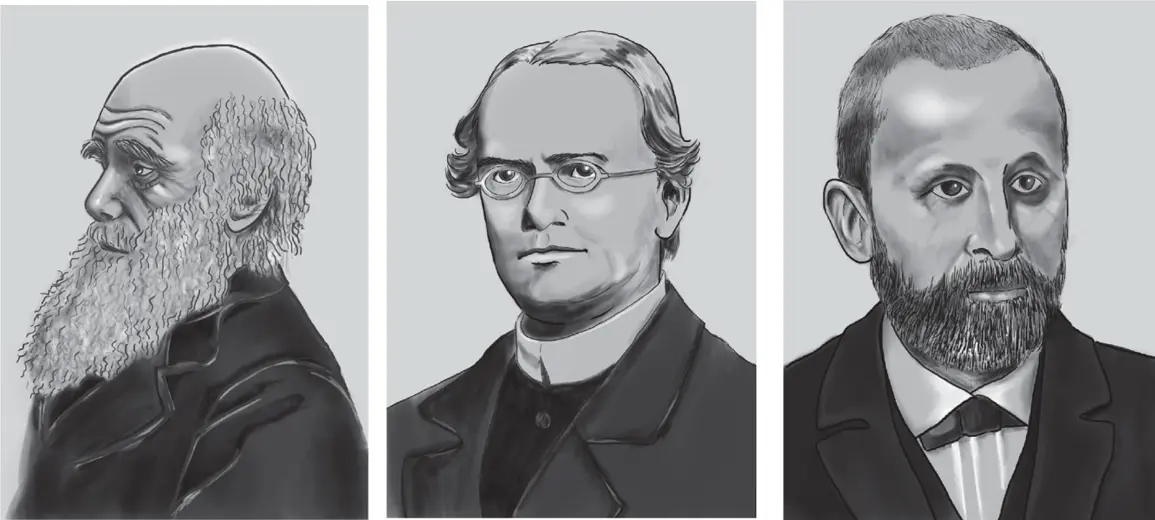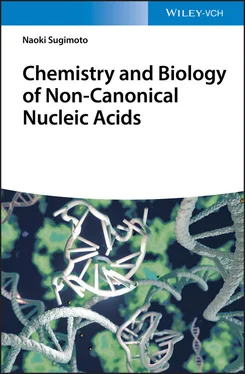Print ISBN:978-3-527-34521-2 ePDF ISBN:978-3-527-81788-7 ePub ISBN:978-3-527-81786-3 oBook ISBN:978-3-527-81785-6
In chemistry and biology, one of the most important and interesting research subjects is nucleic acids: DNA and RNA. The nucleic acids consist of very simple materials: phosphate, sugar, and organic bases. Their structures are also very simple as single strands or a double helix, in comparison with another biomolecules such as proteins and carbohydrates; however the nucleic acids have very important genetic information and functions.
As I mentioned in the Introduction in Chapter 1, there is close to 70 years history in nucleic acid research after the discovery of the double helix DNA structure ( B-form ) as the canonical one by James Dewey Watson and Francis Harry Compton Crick in 1953 and chemical biology of nucleic acids are facing to new aspect today, that is, non-canonical nucleic acids . Through this book, I expect that readers understand how uncommon structure of nucleic acids became one of the common structures as non-canonical nucleic acids that fascinate us now. This new research field for non-canonical nucleic acids will soon big-spark at the interface of chemistry and biology.
This book is comprised of 15 chapters covering various aspects of chemistry and biology of non-canonical nucleic acids including not only their history, structures, stabilities, and properties but also their functions on transcription, translation, regulation, telomere, helicases, cancers, neurodegenerative diseases, therapeutic applications, nanotechnology, and future outlook. This book is a valuable resource, not only for graduate students but also researchers in the fields of physical chemistry, organic chemistry, inorganic chemistry, analytical chemistry, biochemistry, biophysics, structural biology, computational biology, molecular medicine, molecular biology, cell biology, and nanotechnology and who would like to learn more about the potential important roles of non-canonical nucleic acids as well as canonical ones.
I wish all readers enjoy this book and know the importance of not only Watson–Crick double helical nucleic acids ( B-form ) but also non-canonical nucleic acids like triplex and quadruplex. Instead of Hamlet by written by William Shakespeare, please answer the question “To B or not to B, that is the question” in the research field of nucleic acids.
I am deeply grateful to my colleagues in FIBER (Frontier Institute for Biomolecular Engineering Research), Konan University, for their excellent contribution to my writing as the co-authors at the following each chapter. They are Dr. Shuntaro Takahashi (for Chapters 1, 4, 5, 8, 9, 14, and 15), Dr. Tamaki Endoh (for Chapters 2, 7, 10, 13, and 15), and Dr. Hisae Tateishi-Karimata (for Chapters 3, 6, 11, 12, and 15), whose efforts have immeasurably improved the quality and accuracy of the information. I am also deeply grateful to Ms. Miwa Inada for designing a lot of figures and Ms. Katherine Wong and Dr. Lifen Yang in Wiley for their editing this book and encouraging me.
Naoki Sugimoto
Frontier Institute for Biomolecular Engineering Research (FIBER)
Graduate School of Frontiers of Innovative Research
in Science and Technology (FIRST)
Konan University
Kobe, Japan
1 History for Canonical and Non-canonical Structures of Nucleic Acids
The main points of the learning:
Understand canonical and non-canonical structures of nucleic acids and think of historical scientists in the research field of nucleic acids.
This book is to interpret the non-canonical structures and their stabilities of nucleic acids from the viewpoint of the chemistry and study their biological significances. There is more than 60 years' history after the discovery of the double helix DNA structure by James Dewey Watson and Francis Harry Compton Crick in 1953, and chemical biology of nucleic acids is facing a new aspect today. Through this book, I expect that readers understand how the uncommon structure of nucleic acids became one of the common structures that fascinate us now. In this chapter, I introduce the history of nucleic acid structures and the perspective of research for non-canonical nucleic acid structures (see also Chapter 15).
The opening of the history of genetics was mainly done by three researchers. Charles Robert Darwin, who was a scientist of natural science, pioneered genetics. The proposition of genetic concept is indicated in his book On the Origin of Species published in 1859. He indicated the theory of biological evolution, which is the basic scientific hypothesis of natural diversity. In other words, he proposed biological evolution, which changed among individuals by adapting to the environment and be passed on to the next generation. However, that was still a primitive idea for the genetic concept. After that, Gregor Johann Mendel, who was a priest in Brno, Czech Republic, confirmed the mechanism of gene evolution by using “factor” inherited from parent to children using pea plant in 1865. This discovery became the concept of genetics. At the almost same time in 1869 as Mendel, Johannes Friedrich Miescher, who was a biochemist in Swiss, discovered nucleic acids as a chemical substance of the gene identity. He named it “nuclein” (later, it was named “nucleic acid,” which exists acidic substance in nucleus) and made the opportunity to study nucleic acid chemistry. However, it would be doubtful if he realized that nucleic acid is the gene identity. After that, it was needed to take a lot of time to conclude that the gene identity is proved the chemical substance.
 Charles Robert Darwin (left), Gregor Johann Mendel (middle), and Johannes Friedrich Miescher (right)
Charles Robert Darwin (left), Gregor Johann Mendel (middle), and Johannes Friedrich Miescher (right)
Erwin Rudolf Josef Alexander Schrödinger, who was a great physicist, pioneered to go after the mystery of gene. He published a book titled What Is Life ? in 1944 [1]. This book invited the study of the gene to many researchers. He mentioned in the book that he believed a gene – or perhaps the whole chromosome fiber – to be an aperiodic solid, although he also mentioned that gene is probably one big protein molecule. After the 1950s, chemistry regarding nucleic acids had been developing. One of the organic chemists was Erwin Chargaff, who was a professor at Colombia University in the United States and born in Austria. He discovered that from the result of paper chromatography targeted to the different types of DNA, the number of guanine units equals the number of cytosine units and the number of adenine units equals the number of thymine units [2]. It is called Chargaff's rules. On the other hand, analysis of the superstructure of nucleic acids was also proceeding. At the beginning of the 1950s, at King's College London, the results of X-ray crystal analysis were accumulated by Maurice Hugh Frederick Wilkins, Rosalind Elsie Franklin, and others. Finally, based on their result, Watson and Crick who worked at Cavendish Laboratory in Cambridge and proposed the model of double helix structure of DNA ( Figure 1.1and see Chapter 2), published as a single-page paper about DNA double helix in Nature issued on 25 April 1953 [3]. By discovering DNA double helix structure, Watson, Crick, and Wilkins were awarded the Nobel Prize in Physiology or Medicine in 1962.

Читать дальше

 Charles Robert Darwin (left), Gregor Johann Mendel (middle), and Johannes Friedrich Miescher (right)
Charles Robert Darwin (left), Gregor Johann Mendel (middle), and Johannes Friedrich Miescher (right)











